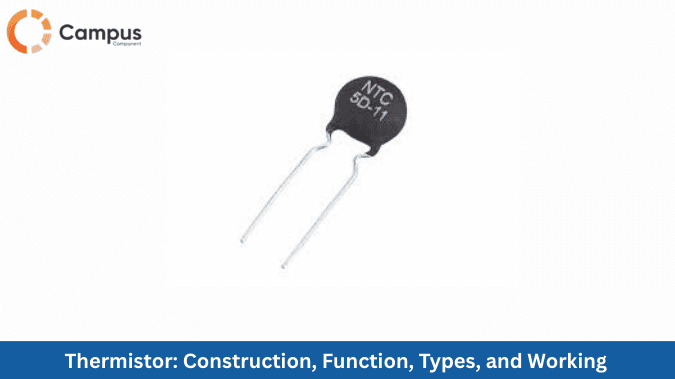
What is Thermistor?
Thermistor is a temperature sensor which is made from semiconductor materials. The resistance of thermistor changes with temperature. The word thermistor made from two words: Thermal & Resistor, which means it is a resistor which is highly sensitive to temperature variations. Thermistor is often used with various semiconductor devices. Like in relays, when thermistor detects the particular temperature exceeds a present threshold, the microcontroller activates a relay switch to turn ON/OFF cooling fans, heaters and protect the circuit from damage. Thermistor is widely used in electronics, industrial automation because of its accuracy, fast response and cost-effectiveness.
Functions of Thermistor
1. Thermistors are mainly used for sensing the temperature in electronic devices. Their resistance changes with temperature which allows them to measure precise thermal variations when they are interfaced with microcontrollers, ADC converters or voltage dividers.
2. By activating the relays or switches, thermistor regulates heating and cooling systems when a temperature reaches the threshold.
3. Thermistor corrects temperature related variations in circuits/ devices like oscillators, amplifiers and sensor circuits.
4. To prevent overheating, overcharging in smartphones, laptop and EVs, thermistor are used.
5. For detecting and logging environmental temperature change, thermistor are used in weather stations.
Types of Thermistor
Thermistors are classified into two types depending on how they vary resistance with temperature:
1. PTC Thermistor (Positive Temperature Coefficient)
In PTC thermistor, resistor increases as the temperature rises. When a temperature reach at certain threshold, resistance rises sharply and limits the flow of current and provides protection. It is useful in safety, protection and thermal control applications like overcurrent protection in power circuits, self-regulating heating elements, relay and switch control in temperature sensitive circuits etc.
2. NTC Thermistor (Negative Temperature Coefficient)
In NTC thermistor, temperature increases as resistance decreases. In this thermistor, when the temperature rises, the number of charge carriers in the semiconductor material increases which leads to a reduction in resistance. NTC thermistor have high sensitivity and accuracy for precise temperature monitoring. They are used in applications like temperature measurement and sensing in microcontroller and ADC systems, battery monitoring in smartphones, laptops and EVs etc.
Working principle of Thermistor
Thermistor’s semiconductor material responds to the variations, when the surrounding temperature changes.
The resistance of the thermistor either decreases or increasesdepending on the type of thermistor.
In most applications, a thermistor is placed in a voltage divider circuit, where resistance changes are converted into measurable voltage signals.
This voltage can be fed into microcontrollers, ADC converters, or amplifiers for accurate temperature measurement and control.
Based on the processed data, the system can trigger relays, switches, or protective circuits to maintain safe operation.
Advantages of NTC & PTC Thermistor
1. NTC Thermistor
Provides precise temperature readings within narrow ranges, ideal for sensors in medical devices, battery packs, and HVAC systems.
Small size and low manufacturing cost make them ideal for consumer electronics and automotive systems.
Capable of detecting even minute temperature variations.
Reduces high surge current in power supplies and chargers, protecting capacitors and rectifiers.
Can be used in simple voltage divider circuits for digital processing through ADC converters.
Helps stabilize frequency in oscillators, amplifiers, and sensor circuits.
Reacts quickly to temperature changes, ensuring real-time monitoring and control.
2. PTC Thermistor
Acts like a resettable fuse, automatically protecting circuits from overcurrent and returning to normal once cooled.
Prevents overheating in motors, transformers, and power circuits.
Offers long-term reliability in industrial and automotive applications.
Performs well in rugged environments where consistent protection is needed.
Provides temperature-based triggering in protection circuits.
In certain applications, PTC thermistors can serve as self-regulating heaters due to their rising resistance.
Applications of NTC & PTC Thermistor
1. PTC Thermistor
Acts as a resettable fuse in power circuits, consumer electronics, and industrial machinery.
Safeguards motors in automobiles, HVAC compressors, and industrial equipment from overheating.
Used in dehumidifiers, heating pads, and defrosting systems due to their self-limiting current feature.
Used in coffee makers, toasters, and hair dryers to regulate heating safely.
Prevents thermal damage in AC/DC adapters, chargers, and UPS systems.
Protects sensitive circuits from overvoltage and overcurrent conditions.
Provides automatic triggering in safety and protection circuits.
2. NTC Thermistor
Used in medical devices, HVAC systems, and industrial equipment for precise thermal monitoring.
Protects power supplies, adapters, and chargers by reducing sudden surge currents at startup.
Common in refrigerators, air conditioners, ovens, and washing machines for thermal control.
Used in digital thermometers, incubators, and patient monitoring systems for high accuracy.
Monitors engine temperature, exhaust gas, and battery packs in vehicles.
Stabilizes oscillators, amplifiers, and sensor circuits against temperature variations.
Frequently Asked Questions
1. What are thermistors made of?
Ans. Thermistors are made of semiconductor materials such as metal oxides (manganese, nickel, cobalt, or copper oxides) sintered into a ceramic form.
2. Is a thermistor a sensor or resistor?
Ans. A thermistor is both a resistor and a temperature sensor, as its resistance varies with temperature.
3. What is the response time of a thermistor?
Ans. The response time of a thermistor typically ranges from a fraction of a second to several seconds, depending on its type and size.
4. What is the difference between NTC and PTC thermistor?
Ans. An NTC thermistor decreases its resistance as temperature rises, while a PTC thermistor increases its resistance with rising temperature.
5. Can a thermistor be used to measure body temperature?
Ans. Yes, a thermistor can be used to measure body temperature accurately, commonly in digital thermometers and medical devices.
6. How accurate are thermistors compared to thermocouples?
Ans. Thermistors are generally more accurate than thermocouples within limited temperature ranges but have a narrower measurement span.
7. Can thermistors be used in water or liquid applications?
Ans. Yes, thermistors can be used in water or liquid applications when they are properly sealed or encapsulated to prevent damage.
8. Can thermistors be used in high temperature applications?
Ans. Thermistors are generally not suitable for very high-temperature applications, as they are designed for low to medium temperature ranges.

